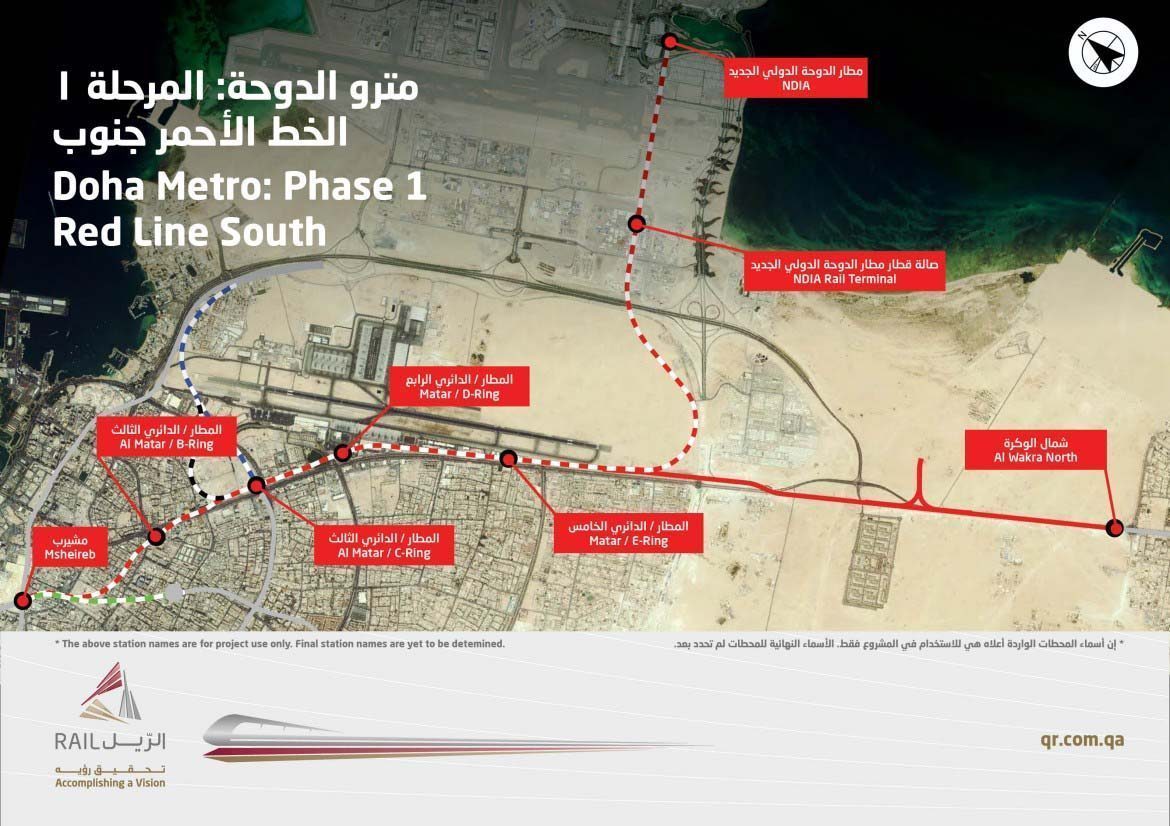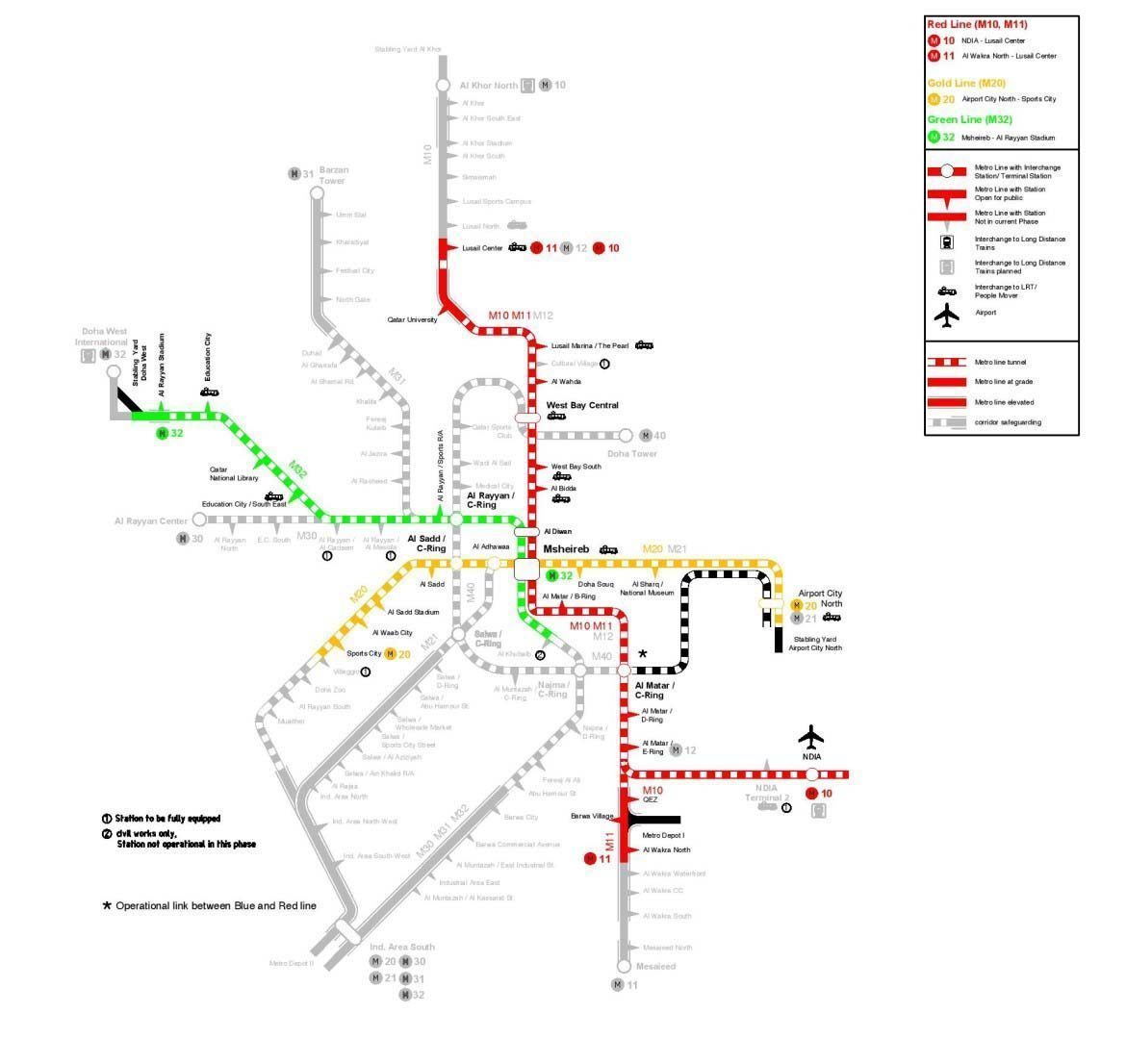
Contractors working on the Doha Metro have excavated 18.6km of the tunnels (about 20 percent) on the massive transportation project, which officials say remains on track to start operating in late 2019.
The first phase of the public transit project, which is intended to ease Doha’s worsening traffic jams as well as move large numbers of football fans around the country during the 2022 World Cup, will consist of 37 stations.
However, Qatar Rail said today that not all stations will be immediately accessible to the public.
Officials said that roughly QR65 billion (US$17.86 billion) worth of contracts have been awarded so far for the Doha Metro, which will initially consist of four lines:
- The Red Line North, running from a connection with Lusail’s light-rail line to Msheireb via West Bay;
- The Red Line South, running from Msheireb to Mesaieed, with a branch to Hamad International Airport;
- The Green Line, running from Al Rayyan Stadium to Msheireb via Education City; and
- The Gold Line, running from Villaggio Mall to the area around the old Doha International Airport, via Msheireb.
Material distributed to journalists today during an update on the metro’s progress contained alternative names for the lines.
The Red Line is referred to as the Coast Line, Green the Education Line, Gold the Historic Line. However, a spokesperson for Qatar Rail said later in the day that these are not the official names of the various lines.
Constructing all the lines simultaneously makes Qatar’s project one of the largest metro systems under construction on the planet.
“No where else in the world, as far as I’m concerned, builds such a massive project all at the same time, in such a short time,” said Samuel Mcchesney, the project director of the Gold Line who spent more than a decade working on Singapore’s metro system.
“Usually you’d do one line first for four or five years, then you’d do the next one … But obviously we’ve got the FIFA World Cup, so it has to be done and it will be done. It’s basically on schedule at the moment and we see no problem with meeting the date.”
Digging
Mcchesney was speaking to reporters at the Al Sudan station construction site, located on the Gold Line just off Al Waab St., near the Doha Expressway.

Two pairs of tunnel boring machines (TBMs), set to drill parallel tunnels in either direction, could be seen at the bottom of a large pit that will eventually be the station, 25 meters below the surface.
German firm Herrenknect has delivered all 21 tunnel boring machines to Qatar, and 17 of them are currently working in operation, officials said today.
Mcchesney said the Gold Line’s TBMs operate 24 hours a day, six days a week. On average, the machines will advance between 15 and 20 meters daily, he added.
Excavation is expected to be complete by mid-2017, at which time construction crews will turn their focus to fitting out the tunnels with rails, lighting, electricity and ventilation systems, as well as building the actual stations.
What’s underground?
Mcchesney said crews have so far encountered good subterranean conditions for tunneling.

“Here, the soil is like a soft rock. It will stand up on its own. We have no real problem with ground stability,” he told Doha News.
“Sometimes, underground (materials) can just be like a soup (of) sand and water (that) just totally collapses when you expose it.”
While conditions on the Gold Line may be relatively dry, especially as it heads to Villaggio Mall, contractors face challenges of groundwater on stretches of the network closer to Doha Bay.
In February, a significant amount of water entered one of tunnels being dug between Msheireb Station and Al Bidda Station. While no one was injured, the flood damaged the TBM and caused work to grind to a halt.
Qatar Rail said today that the TBM is currently being repaired and may be ready for a re-launch by next month.
Speaking to Doha News, Qatar Rail CEO Saad Ahmed Al Muhannadi said the flooding incident would not affect the timeline of the metro project because work was operating five months ahead of schedule on the line at the time of the flooding.
“There was some lessons learned from this incident. All additional precautions was taken to avoid repeating this incident,” he said.
Long-distance rail
Officials also touched upon progress of Qatar’s other rail projects.
The long-distance passenger and freight line is still scheduled to enter operations by 2018, despite reported delays in the qualifying of contractors.
Meanwhile, all the tunneling for Lusail light-rail line – which will connect to the Doha Metro – was completed in 2013. Like the Metro, the Lusail LRT is expected to open to passenger traffic in 2019 and contain 37 stations.
That’s two years later than previously stated, although many of the separate projects to construct Lusail’s homes and offices that will create demand for the LRT have also fallen behind schedule.
The 38km LRT network will be spread across four separate lines.
The installation of a public transport system in Qatar is expected to take the pressure off the nation’s crowded road network, which is struggling to accommodate the thousands of new cars that join it each year.
“This is a network that will be an alternative to private transport,” said Hamad Ibrahim Al Bishri, Qatar Rail’s deputy CEO.
The second phase of the Doha Metro is projected to be completed by 2026, adding another 70-odd stations to transit system.
The rail network will be extended by approximately 146km by extending the existing lines further out of Doha and building a parallel Gold Line west of Msheireb.
Additionally, phase two includes a new Blue Line that loops in a semicircle from West Bay, through Al Sadd and towards the airport on a route that appears to roughly follow C-Ring Rd.
With the exception of the new Blue Line, which will be completely underground, most of the second phase will be constructed at ground level or on elevated tracks.
dohanews.co







